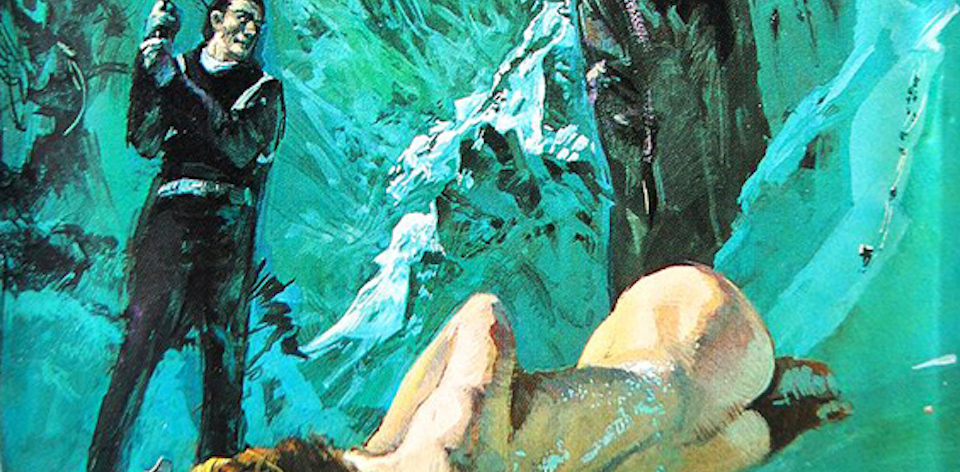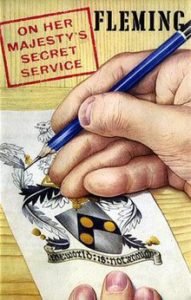Bond. James Bond. Is there a name more synonymous with spying, tuxedos, and shaken cocktails than the British secret agent? Join me as I read all of the James Bond books in 007 Case Files, encompassing Ian Fleming and beyond. For Your Eyes Only: there’s potential spoilers ahead.
Ian Fleming’s tenth Bond novel (and eleventh James Bond book) is a culmination of many things for the writer. Written while filming was underway for Dr. No nearby in Jamaica, Fleming follows the misfired character-based work of The Spy Who Loved Me by turning that laser focus towards his most famous creation. This is Bond at his most human and relatable, and your acceptance of that will all depend on why you show up to these parties.
The middle part of the “Blofeld trilogy” – following the oft-mentioned events of Thunderball – Fleming opens the book with a rare bit of introspection. As Bond spies on Tracy, the love interest and catalytic plot device, he reflects on his own idyllic childhood. Bond’s past barely gets a mention in the earlier books, and certainly nothing is ever given up that would detract from Fleming’s use of the character as a blunt instrument.
The primary plot is simplicity itself. After composing a letter of resignation from the service (yet again), frustrated as he is with the MI6 insistence that he continue pursuing Blofeld, Bond encounters the suicidal Tracy. The daughter of the head of the Unione Corse mafia, Bond uses that connection to lead him towards Blofeld. From there it’s pretty straightforward Bondage: a mountain lair, hypnotised women delivering biological weapons, and a daring escape on skis. Yet it’s the weaving together of these high-concepts with Bond’s moments of romantic and domestic self-realisation that elevate ON HER MAJESTY’S SECRET SERVICE above its immediate predecessor, ultimately making the infamous ending all the more impactful.

In Tracy we have something of a contradiction. She is initially presented as someone who could be Bond’s equal in daring, driving, and passion. Modern critics would probably see her as a Mary Sue save for a few key differences. Like many of the so-called ‘Bond Girls,’ Tracy arrives “broken” in some way: “Oh, lord! thought Bond. One of those! A girl with a wing, perhaps two wings, down.” Fleming has previously saddled his female leads with histories of rape and abuse, physical scars, or even the feature-length cautionary morality tale ofThe Spy Who Loved Me. Here Fleming tackles mental illness, and while many of the clumsy discussions come from a place of misunderstanding, there’s at least some recognition of Tracy’s recovery being a process – and not simply needing a big strong man to fix it all. So, it’s a shame that once her coupling with James turns into a romance narrative, she is mostly reduced to pining and catering to Bond’s every whim. What was that I was saying about Mary Sues?
Which is as good a segue as any to bringing up those 1960s-by-way-of-the-19th-century idiosyncrasies Fleming peppers his prose with. Up until this point, Fleming has spoken about “blithering women” (Casino Royale), constructed some kind of hierarchy of races (Live and Let Die, Doctor No, “Quantum of Solace”) and contended (in From Russia with Love) that all women “long to be slung over a man’s shoulder and taken into a cave and raped.”
So it’s probably no surprise that Fleming returns to that latter point in ON HER MAJESTY’S SECRET SERVICE again: one character reports that “she must have been possessed by a subconscious desire to be raped.” (I know you’ve been dead for 55 years, Ian Fleming, but just for the record: rape, by definition, is not something you can “desire.”) This is also a book where such “stubborn disabilities” as “alcoholism, drug-taking, and homosexual tendencies” could get “successful treatment” through hypnosis. A National Diversity Award winner Ian Fleming was not.
Fleming is at his strongest when he sticks to the core elements that were months away from being translated to the screen. As Bond escapes from SPECTRE operatives while skiing, or is caught in a mid-air assault on the enemy stronghold, Fleming’s undeniable visual panache is in full effect. Even in the confines of a hotel or casino, Fleming’s descriptors completely immerse us with minute details that only a person with a life in the service could deliver.
While this might be the Empire Strikes Back of the Blofeld Saga, it’s also a tragic full circle with Casino Royale. Near the start of the story, it’s revealed that Bond visits the unassuming grave of Vesper Lynd, the woman who both loved and betrayed him in the first Bond novel. Now ten books later, Bond is ready to make a commitment again, only to have Tracy snatched away from him with an assassin’s bullet. While this is far from the final Bond story told, and the penultimate one published in Fleming’s lifetime, it could have served as a finale for the character (albeit with a downer of an ending). Instead, Fleming would give Bond another chance at revenge and redemption in You Only Live Twice the following year.





